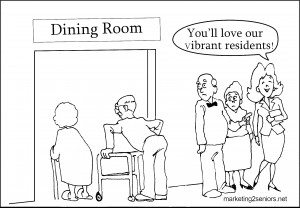
by Diane Masson | Jan 11, 2015
 It’s flu season and I unfortunately succumbed with a 100.8 temperature reading and a horrible cough. My husband, Chris, was sicker than I. As we nursed each other back to health, I thought about single seniors trying to manage flu symptoms alone in their home.
It’s flu season and I unfortunately succumbed with a 100.8 temperature reading and a horrible cough. My husband, Chris, was sicker than I. As we nursed each other back to health, I thought about single seniors trying to manage flu symptoms alone in their home.
What if a senior didn’t have enough groceries stocked at home? What if they were too weak to even make themselves a can of soup? Would they monitor their own temperature and take Tylenol every six hours? What about drinking enough liquids? Will anyone check on his or her well-being?
The flu has not struck at the Continuing Care Retirement Communities that I represent. It makes me feel good to know if one of our residents got the flu, in the independent living setting, room service could bring them a meal of soup, fruit and tea or what they need to start healing. If a senior resident wondered if they need to be hospitalized they could walk down the hall to the complimentary wellness clinic and ask the nurse. If they were really bad the senior resident could pull their emergency cord and a nurse or emergency medical technician would come help them. Wow! I did not have that luxury. Frankly, I could have used it Friday night when I considered going to the emergency room, because it was getting hard to breathe.
Assisted living and skilled nursing support residents 24-hours a day, so if a senior got the flu, they have caregivers who can nourish them back to health.
Some critics might say that a community setting promotes the spread of flu, with all those people living and dining together. There are small steps senior living communities can do to reduce this challenge. First and foremost, install hand sanitizer in strategic places in the community, such as the lobby and dining room entrances. Second, promoting flu shots. Plus if people are sick, such as myself, they just need to stay at home to reduce the spread of infection.
What are your thoughts? Is it better to have the flu isolated in your home or in a senior living community?
With experience as both an industry expert and a loving daughter, Diane Twohy Masson is passionate about helping seniors find the retirement community that fits their price range, lifestyle, and needs. Her new guidebook offers a proactive approach to navigating the complex maze of senior housing options. It will help you understand the costs and consequences of the various possibilities, from home care to independent living, assisted living, group homes, memory care, and skilled nursing-care facilities.
“Your Senior Housing Options,” will be coming soon to Amazon.com. If you sign up for my weekly newsletter on the right side of this blog, you will be notified when my new book becomes available. Check out my new website: Tips2Seniors.com or please follow me on Facebook.
Diane Twohy Masson is the author of “Senior Housing Marketing – How to Increase Your Occupancy and Stay Full,” available at Amazon.com with a 5-star rating. The book is required reading at George Mason University as a part of its marketing curriculum. Within this book, the author developed a sales & marketing method with 12 keys to help senior living providers increase their occupancy.

by Diane Masson | Oct 12, 2014
 Does every assisted living and skilled nursing community in America serve a dessert to their residents for lunch AND dinner? Is this too much sugar? Can sugar cause or increase dementia and Alzheimer’s?
Does every assisted living and skilled nursing community in America serve a dessert to their residents for lunch AND dinner? Is this too much sugar? Can sugar cause or increase dementia and Alzheimer’s?
My mom lived in assisted living for 7 years and had desserts twice a day. Now, she has lived in skilled nursing for 17 months with desserts twice a day and don’t forget the occasionally ice cream snack or the birthday party with cake. She has progressed over nine years from some memory loss to full blown vascular dementia. Was it life, genes or could sugar have helped it along? What is your opinion?
Fact: It is very hard for me to walk away from a good piece of chocolate. I am a sugar addict. Then I started reading about sugar causing inflammation in the body according Dr.Daniel Amen and how sugar can lead to dementia according to New York Times’ best selling author David Perlmutter, MD. When I started eating more that 12 pieces a day, I decided to give up sugar.
Every month, I am a presenter at four or more marketing luncheons for prospective residents. The lunches are outstanding and always end with a spectacular dessert. This week it was a cheesecake with strawberry sauce. I said no thank you. As the excellent servers are glancing around and notice that I don’t have a dessert, they come over to offer me one again. Sometimes I have had to say no to dessert three times at one luncheon. It is tough to give up sugar!
Temptation is everywhere! There is always a birthday celebration with cake, candy in the office, bakeries and here comes Halloween candy. Do you nibble or eat as much as possible? Do think it will cause us to have dementia sooner?
How many of us working folks eat two desserts every day? Is it bad that we feed two desserts to our seniors with dementia twice a day in our assisted living and skilled nursing care communities?
Diane Twohy Masson writes this weekly blog to support and engage with other senior housing professionals. Her first book is Senior Housing Marketing – How To Increase Your Occupancy and Stay Full. Many sales teams and organizations have used the 12 keys contained in this book for their weekly book review.
Diane Masson has recently created a New Guide for the Silver Tsunami. Her latest book offers a pro-active approach for a senior to navigate his or her way through the senior housing market. “Selecting Senior Housing Options for Seniors IN the Silver Tsunami” is coming soon to Amazon.com. www.tips2seniors.com
© Marketing 2 Seniors| Diane Twohy Masson 2014 All Rights Reserved. No part of this blog post may be reproduced, copied, modified or adapted, without the prior written consent of the author, unless otherwise indicated for stand-alone materials. You may share this website and or it’s content by any of the following means: 1. Using any of the share icons at the bottom of each page. 2. Providing a back-link or the URL of the content you wish to disseminate. 3. You may quote extracts from the website with attribution to Diane Masson CASP and link https://www.marketing2seniors.net For any other mode of sharing, please contact the author Diane Masson.

by Diane Masson | Jun 22, 2014
 The prospect may say, “I want to think about it.” “I am one or two years away.” “I am not ready yet.” “I am not interested in a pushy salesperson.” Will you still call them back promptly the next day? If not, why not??
The prospect may say, “I want to think about it.” “I am one or two years away.” “I am not ready yet.” “I am not interested in a pushy salesperson.” Will you still call them back promptly the next day? If not, why not??
The senior living prospect walked in your door for a reason. They need your services or are considering your services. They should automatically be classified as warm if they walked into your senior living community. They may be eating cereal for dinner or sleeping in a recliner chair because the alternatives are too much effort. This is a viable lead that deserves your time and attention, even if they say, “I am not ready yet.”
I find it appalling that some senior living sales people will only give the time of day to a senior that can move in now. Ultimately, they are neglecting potential sales. In my experience, only 25% of the seniors say, “I am ready now.” “My home is on the market.” “My kids say I have to move immediately.” “My doctor recommends that I move to assisted living right away.”
So this means that the other 75% of potential seniors are too scared to express their needs. They say a quick statement in the beginning to protect themselves from being SOLD by you. They have lived in their home for 40 or 50 years. They don’t WANT to move. They are just beginning to UNDERSTAND that a move would be beneficial to their health and well-being.
Educate this scared senior and show how your Retirement Community, Assisted Living or Continuing Care Retirement Community is the best choice for them. Then watch your occupancy rise. The end result will be providing solutions to improve the quality of life for a multitude of seniors.
Do you call EVERY tour back the next day? If not, why not??
Your tips could help others improve on a national basis, so please share by commenting on this blog. If this weekly blog can help your sales and occupancy – why not invite your team to sign up today so no one misses a single tip to improve the occupancy?
Diane Twohy Masson writes this weekly blog to support and engage with other senior housing professionals. Her first book is Senior Housing Marketing – How To Increase Your Occupancy and Stay Full. Many sales teams and organizations have used the 12 keys contained in this book for their weekly book review. Diane is working on her second book to help seniors select their senior housing options.
© Marketing 2 Seniors| Diane Twohy Masson 2014 All Rights Reserved. No part of this blog post may be reproduced, copied, modified or adapted, without the prior written consent of the author, unless otherwise indicated for stand-alone materials. You may share this website and or it’s content by any of the following means: 1. Using any of the share icons at the bottom of each page. 2. Providing a back-link or the URL of the content you wish to disseminate. 3. You may quote extracts from the website with attribution to Diane Masson CASP and link https://www.marketing2seniors.net For any other mode of sharing, please contact the author Diane Masson.

by Diane Masson | May 11, 2014

After a senior has been diagnosed with a progressive disease such as macular degeneration of the eyes, the onset of blindness, dementia, brain tumor, stroke, cancer, etc. – one of two things can happen:
- The senior gets their affairs in order and prepares for someone to care for them when they no longer can.
- They go into denial.
As a senior’s disease progresses they may come and tour at your community or mine. It is very difficult to know that this senior may be in an unsafe situation in his or her home. I think it affects each of us who are caring professionals in the senior housing industry. Yet, the senior refuses to bring in help to their home or move to retirement or assisted living community. It becomes even harder when the adult children are extremely worried. They may be begging you to talk his or her parent into moving into your senior living community.
I believe the biggest reason this type of senior does nothing is because they are only living in the moment instead of recognizing the potential hazards of their health deteriorating further.
What can we do to unfreeze seniors who may be at risk?
- Ask great questions
- Find out why they decided to tour your community today
- Inquire about what is most important for them
- Help them recognize they have a challenge
- Try to have them vocalize their plan for when they can no longer take care of themselves
- Educate them on potential future outcomes
As a professional senior living expert, who has the best interests of the senior at heart, what have you said or done to help unfreeze a senior?
Please share your successes, failures or comment below to join the conversation and interact with other senior living professionals on what is currently being effective to increase occupancy on a nationwide basis.
Diane Twohy Masson is the author of “Senior Housing Marketing – How to Increase Your Occupancy and Stay Full,” available at Amazon.com with a 5-star rating. The book is required reading at George Mason University as a part of its marketing curriculum. Within this book, the author developed a sales & marketing method with 12 keys to help senior living providers increase their occupancy. Masson developed this expertise as a marketing consultant, sought-after blogger for senior housing and a regional marketing director of continuing care retirement communities in several markets. She has also been a corporate director of sales and a mystery shopper for independent living, assisted living, memory care and skilled care nursing communities in multiple states. Currently, Masson is setting move-in records as the regional marketing director of two debt-free Continuing Care Retirement Communities in Southern California – Freedom Village in Lake Forest and The Village in Hemet, California. Interestingly, this career started when she was looking for a place for her own mom and helped her loved one transition through three levels of care.
© Marketing 2 Seniors| Diane Twohy Masson 2014 All Rights Reserved. No part of this blog post may be reproduced, copied, modified or adapted, without the prior written consent of the author, unless otherwise indicated for stand-alone materials. You may share this website and or it’s content by any of the following means: 1. Using any of the share icons at the bottom of each page. 2. Providing a back-link or the URL of the content you wish to disseminate. 3. You may quote extracts from the website with attribution to Diane Masson CASP and link https://www.marketing2seniors.net For any other mode of sharing, please contact the author Diane Masson.

by Diane Masson | Apr 27, 2014
 Many senior living communities say, “We will take care of you for the rest of your life.” Really? What if a senior legitimately runs out of his or her resources? Can they still stay for life? Is it a marketing spiel or a real guarantee? What promise is really written in the resident’s contract? Do they offer at least three levels of care including skilled nursing?
Many senior living communities say, “We will take care of you for the rest of your life.” Really? What if a senior legitimately runs out of his or her resources? Can they still stay for life? Is it a marketing spiel or a real guarantee? What promise is really written in the resident’s contract? Do they offer at least three levels of care including skilled nursing?
Senior living communities can talk about a “fund” to help residents or a “Good Samaritan Fund.” My own mom was lucky enough to benefit from this type of fund. I never dreamed in a million years that my mom would live in a higher level of care like assisted living for so many years (seven to be exact). In the middle of those seven years, my mom ran out of her resources. She has social security, an annuity, a pension and a savings account. Her savings account depleted down to $2,000.
Thank goodness my mom’s Continuing Care Retirement Community (CCRC) had a Good Sam Fund that was developed out of generous donations. The little known fact was that only 10 seniors could benefit from the fund at any given time. My mom was number 10. I never knew if there was a resident whose number was 11 or higher that never received financial help.
Now, I know about two CCRC’s in CA that offer a Guarantee of Care for life. It is straight up and clearly written in the contracts at Freedom Village in Lake Forest and The Village in Hemet.
An attorney compared CCRC contracts in Orange County and determined that all were not equal in the guarantee of care for life. Some are straight up and others offer, “A guarantee of care for life,” but add three extra words following this statement in the contract… those three extra words are, “At our option.”
“At our option,” sounds a lot like a Good Sam Fund that has a limited amount of resident users. What do you think?
Please share your successes, failures or comment below to join the conversation and interact with other senior living professionals on what is currently being effective to increase occupancy on a nationwide basis.
Diane Twohy Masson is the author of “Senior Housing Marketing – How to Increase Your Occupancy and Stay Full,” available at Amazon.com with a 5-star rating. The book is required reading at George Mason University as a part of its marketing curriculum. Within this book, the author developed a sales & marketing method with 12 keys to help senior living providers increase their occupancy. Masson developed this expertise as a marketing consultant, sought-after blogger for senior housing and a regional marketing director of continuing care retirement communities in several markets. She has also been a corporate director of sales and a mystery shopper for independent living, assisted living, memory care and skilled care nursing communities in multiple states. Currently, Masson is setting move-in records as the regional marketing director of two debt-free Continuing Care Retirement Communities in Southern California – Freedom Village in Lake Forest and The Village in Hemet, California. Interestingly, this career started when she was looking for a place for her own mom and helped her loved one transition through three levels of care.
© Marketing 2 Seniors| Diane Twohy Masson 2013 All Rights Reserved. No part of this blog post may be reproduced, copied, modified or adapted, without the prior written consent of the author, unless otherwise indicated for stand-alone materials. You may share this website and or it’s content by any of the following means: 1. Using any of the share icons at the bottom of each page. 2. Providing a back-link or the URL of the content you wish to disseminate. 3. You may quote extracts from the website with attribution to Diane Masson CASP and link https://www.marketing2seniors.net For any other mode of sharing, please contact the author Diane Masson.

by Diane Masson | Apr 6, 2014
 There was an overwhelming response of ideas and tactics through Linked In of “How To Move Someone Saying, “No!” (Part 1).
There was an overwhelming response of ideas and tactics through Linked In of “How To Move Someone Saying, “No!” (Part 1).
Many people felt that you should never force a senior parent to move. Once the conversation specified parents with dementia, then everyone was onboard with possible solutions. Let me sum up the best strategies and “schemes” on how to move someone who is at risk and seems chained to their current home.
- Move your parent directly from a hospital crisis to a senior living community.
- Be ready to transition your parent to an assisted living community when the rehabilitation is over.
- Say, “As soon as you are better, I will move you back to your home.”
- The primary care physician can convince mom or dad that it is time to move and list the reasons why. (This generation is programed to abide by the doctor’s recommendations.)
- Bring a contractor by your parent’s home and say, “We need to work on the house and the plumbing will be shut down for two weeks. You are only going to move temporarily while the house gets worked on…”
- Sample stays of two to seven nights – to test-drive a retirement community.
- Show them where you want them to move and compare with an awful place they dislike.
- Send them to an adult day program for several weeks before moving them in full time.
- Sometimes you just need to push them to the next step when your parent’s health dictates it.
- The safety of your parent means switching the child/parent roles. You the Boomer child becomes the parent and makes the decision.
- Cajoling: Asking for the GIFT of peace-of-mind from worrying about them.
- Cultivating a move can take months. Include as many lunches and residents activities as possible at a prospective senior living community.
FYI – If a retirement community knows that you are struggling they will triple their efforts to help you and support your parent(s) integration into their community.
Remember that 95% of cognitive seniors who move all say, “I wish that I had moved sooner.” Once they start thriving they won’t want to move back to their isolated home. Patience and empathy are two necessary ingredients that must be present for your parent’s transition.
Any more ideas?
Please share your successes, failures or comment below to join the conversation and interact with other senior living professionals on what is currently being effective to increase occupancy on a nationwide basis.
Diane Twohy Masson is the author of “Senior Housing Marketing – How to Increase Your Occupancy and Stay Full,” available at Amazon.com with a 5-star rating. The book is required reading at George Mason University as a part of its marketing curriculum. Within this book, the author developed a sales & marketing method with 12 keys to help senior living providers increase their occupancy. Masson developed this expertise as a marketing consultant, sought-after blogger for senior housing and a regional marketing director of continuing care retirement communities in several markets. She has also been a corporate director of sales and a mystery shopper for independent living, assisted living, memory care and skilled care nursing communities in multiple states. Currently, Masson is setting move-in records as the regional marketing director of two debt-free Continuing Care Retirement Communities in Southern California – Freedom Village in Lake Forest and The Village in Hemet, California. Interestingly, this career started when she was looking for a place for her own mom and helped her loved one transition through three levels of care.
© Marketing 2 Seniors| Diane Twohy Masson 2013 All Rights Reserved. No part of this blog post may be reproduced, copied, modified or adapted, without the prior written consent of the author, unless otherwise indicated for stand-alone materials. You may share this website and or it’s content by any of the following means: 1. Using any of the share icons at the bottom of each page. 2. Providing a back-link or the URL of the content you wish to disseminate. 3. You may quote extracts from the website with attribution to Diane Masson CASP and link https://www.marketing2seniors.net For any other mode of sharing, please contact the author Diane Masson.

 It’s flu season and I unfortunately succumbed with a 100.8 temperature reading and a horrible cough. My husband, Chris, was sicker than I. As we nursed each other back to health, I thought about single seniors trying to manage flu symptoms alone in their home.
It’s flu season and I unfortunately succumbed with a 100.8 temperature reading and a horrible cough. My husband, Chris, was sicker than I. As we nursed each other back to health, I thought about single seniors trying to manage flu symptoms alone in their home.




